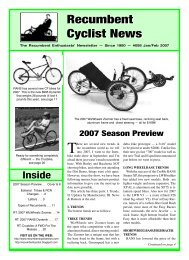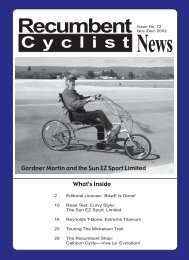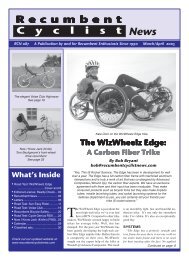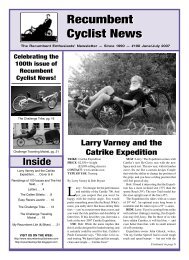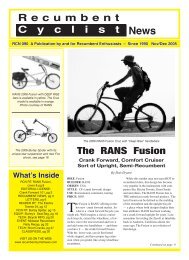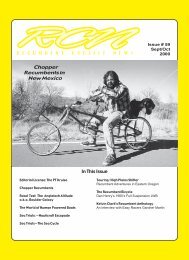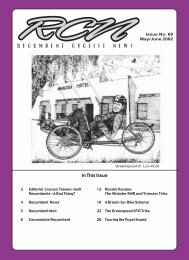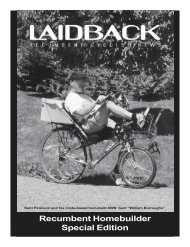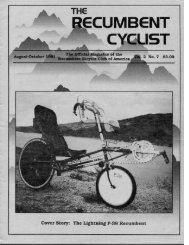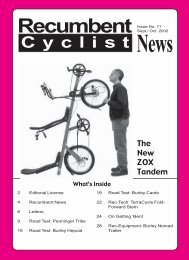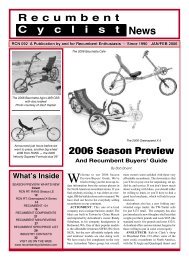C y c l i s t Recumbent - Steve Briggs
C y c l i s t Recumbent - Steve Briggs
C y c l i s t Recumbent - Steve Briggs
You also want an ePaper? Increase the reach of your titles
YUMPU automatically turns print PDFs into web optimized ePapers that Google loves.
Top two finishers in the 75-mile recumbent bike race, John Schlitter (left)<br />
of Hayes, Kan., and Jim Verheul of Westlake Village, Calif., relax after the<br />
race. Both were enthusiastic about the course and conditions.<br />
The The Wasco Wasco Wild Wild West<br />
West<br />
75-Mile 75-Mile <strong>Recumbent</strong> <strong>Recumbent</strong> Race<br />
Race<br />
They came from as far away as Kansas,<br />
Colorado and California, bearing spidery<br />
contraptions of carbon fiber and<br />
titanium, aluminum, Teflon and precision-machined<br />
gears. They came, on May Day, to the<br />
Petersburg School in The Dalles, Oregon, to<br />
challenge themselves and to have a good time.<br />
The event was the first Wasco Wild West 75-<br />
Mile <strong>Recumbent</strong> Bike Race.<br />
What the riders found was a twisty, curvy<br />
course through the rolling hills of Fifteenmile<br />
Road, including an eight percent uphill grade<br />
and a two-mile downhill run, crossing back to<br />
Eightmile and the school again. Four times<br />
6 <strong>Recumbent</strong> Cyclist News<br />
By Rodger Nichols<br />
The Dalles Chronicle<br />
around gave them 75 miles of leg-burning exhilaration.<br />
“It’s beautiful,” said John Schlitter<br />
of Hayes, Kansas, who crossed the finish line<br />
in three hours and 41 minutes, averaging 19.87<br />
miles per hour. “It's an honest course,” he<br />
added. “It makes you earn it.” That's high<br />
praise coming from a rider of his stature. The<br />
week before, he and his Bacchetta Aero were<br />
winning the 167-mile Cross Florida race. Later<br />
he would tell race organizer Clay Smith that it<br />
was the finest road course he had ever raced,<br />
and that he would work to make it the national<br />
championship site for next year. “That would<br />
be fantastic,” said Smith, who was the tireless<br />
organizer and promoter of the event.<br />
Though only 13 riders showed up for this<br />
first go-around, their enthusiasm was universal.<br />
“The course was great,” said John<br />
Cunningham of Peyton, Colorado, who was<br />
contending for third place until he blew a tire<br />
and lost valuable time. “We had very little traffic,<br />
and what traffic we did have was friendly.<br />
They would go wide around us and wave.”<br />
Smith, who organized crews of volunteers to<br />
flag traffic, staff the checkpoints and time the<br />
racers, said he was pleased with the final outcome.<br />
“We got good advance stories in the bike<br />
press,” he said, “and the riders have already<br />
written articles about the event on the Internet.”<br />
Smith has plenty of experience in staging such<br />
events, having been both a rider and a volunteer<br />
with the Aluminum Man Triathlon for a<br />
number of years. He believes The Dalles has a<br />
serious chance of becoming a regular part of<br />
the recumbent bike racing circuit, since the<br />
sport is so young.<br />
Though the sport is young, the recumbent<br />
design itself is old, dating back to the late<br />
1800s. Peugeot, one of the world's oldest and<br />
leading manufacturers, designed and sold thousands<br />
of them after its entry into the field in<br />
1905. Advocates for the style claim it would<br />
likely be the dominant design today if not for<br />
a decision made in 1934 by United Cyclists<br />
Internationale, the bike racing sanctioning<br />
body. After a second-rate rider named Francis<br />
Faure set a new world record for the hour, covering<br />
45.056 kilometers (27.9 miles), the UCI<br />
banned recumbents from sanctioned races.<br />
That decision effectively killed the design for<br />
nearly five decades. It wasn’ until 1979 that<br />
the first modern-era recumbents (or 'bents, as<br />
current riders often call them) were produced.<br />
Their efforts were spurred by chemical giant<br />
DuPont’s announcement of a $15,000 prize for<br />
the first human-powered vehicle to reach 65<br />
miles per hour. A rider affectionately known<br />
as “Fast Freddy” Markham captured the prize<br />
in 1986.<br />
Those who have tried the modern<br />
recumbents tend to be adherents. “They can<br />
be ridden for hours and miles without ailments<br />
such as the sore butt, stiff neck, aching shoulders<br />
or numb hands that afflict the conventional<br />
bicycle rider,” writes Martin Krieg who<br />
has made crossings of the Untied States on both<br />
uprights and recumbents. “The recumbent rider<br />
experiences far greater comfort, a better view<br />
of the world, a toning and strengthening of the<br />
abdomen, even a better sun tanning position.”<br />
“And no, they are not dangerous. In fact the<br />
lower center of gravity and greater proximity<br />
to the ground mean that if you should crash on<br />
one, your feet will absorb most of the shock<br />
instead of your head. Because more of your<br />
weight is over the rear wheel, recumbents also<br />
stop faster. Cars see you better, too, because<br />
the biggest part of your body is in the car



